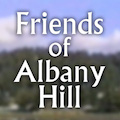January, 1999
Lepidoptera of Albany Hill, Alameda County, California
Jerry A. Powell, Essig Museum of Entomology, University of California, Berkeley
and
Robert L. Langston, Kensington, California
The following list summarizes observations of Lepidoptera (moths and butterflies) at Albany Hill during 1995-98. Data originate from about 75 daytime and crepuscular visits of 0.5 to 3.5 hours, in all months of the year. All of the butterfly species and some of the moths were recorded by RLL. Most of the moth species and their larval host plants by JAP.
A total of 145 species is recorded (30 butterflies, 115 moths), which is a modest number considering the extent and diversity of the flora. However, many of the potential larval host plants may be present in too small patches to support populations of larger moth or butterflies. Nonetheless, we were surprised that colonies of some of the species survive in so small an area, including some rare ones in the East Bay region, as annotated below. Moreover, the inventory is incomplete. A more comprehensive census would be accomplished by trapping moths attracted to ultraviolet lights. In a habitat of this size however, such survey would attract and unknown proportion of species from surrounding areas.
Larval collections are indicated by JAP lot numbers (e.g.95C39=1995, March, 37th collection). Larval foods of most of the other species are documented in other populations. Host plants are recorded at Albany Hill for 75 species (65% of the moths, 52% of the total); the remainder were observed as adults only. 12 species (10%), possibly 14 are non native exotics in California. At least 6 of the butterflies and a few of the moths are vagrants here and/or depend upon plants in subtending urban and weedy areas.
RARE OR UNUSUAL SPECIES, No species is formally designated as endangered or threatened, but several were surprise discoveries, rare or unknown for this area
GREYA RETICULATA (Riley). We found this small moth abundant in late March and early April, in 1995 and 98, using buds of Sanicula Crassicaulis oviposition. After its original description from Los Angeles and Alameda, RETICULATA was ‘lost’ for nearly a century prior to its rediscovery in Santa Clara Co. in the 1960’s, where its larvae feed on Osmorrhiza. Several colonies are known, including San Bruno Mt., San Mateo Co., but there had been no record in the East Bay since 1880’s. Sanicula was not previously known to be a larval host.
PERITTIA CYNGNODIELLA (Busck). Larval mines were abundant on SYMPHORICARPOS in 1995. This species was described from British Columbia and is widespread in the Pacific States but is rare in collections because the adults are inconspicuous, diurnal, and fly in early spring. Larvae had been reared only at San Bruno Mountain previously, and we had not prior record of the species in the East Bay area.
ELACHISTA GILDORELLA (Kaila, ms.) Two individuals of this previously undescribed, grass- mining species were taken at the same spot on the northwest slope of the hill in April 1995 and 1998. This species is known from only two other localities, San Bruno Mt. and Point Reyes.
ELACHISTA MARACHELLA (Kaila, ms.). Several specimens of a second undescribed species were collected on the north slope of Albany Hill in March, April, and June. Larvae were found mining ERHARTA ERECTA in Strawberry Canyon on the UC Berkeley campus in 1978-85. This introduced grass also occurs on Albany Hill, but MARACHELLA is a member of a complex of closely related Californian species, and native grasses presumably serve as larval hosts.
EPINOTIA LOMONANA (Kearfott). This species also is rarely seen, because the adults fly in late fall. It was recorded in Orinda in 1961 and once as a vagrant on urban Berkeley. The larvae feed on native Prunus, and we unexpectedly found a select colony on the patch of P. SUBCORDATA at Albany Hill.
ACLERIS KEIFERI (Powell). Larvae of this species were found on ROSA CALIFORNIA. A. Keiferi was described 35 years ago from specimens collected in San Francisco in the 1920’s and 1930’s, and there were specimens from Berkeley collected in 1931 and Bear Creek (now at the bottom of Briones Reservoir) in 1957. It remained unknown in the East Bay area until 1993 when we discovered a colony on Brooks Island, also feeding on Rosa California. Elsewhere the larvae have been found on Rubus and Fragaria.
OLDAEMATOPHORUS OCCIDENTALIS, (Walsingham). This species, which we have not seen from the Bay Area previously, was originally described from Colusa and Shasta Counties. At Albany Hill the larvae are suspected to feed on Wyethia Amgustifolia and/or Grindelis hirsutula, baed on records in British Columbia.
BATTUS PHILENOR, (Pipe Vine Swallowtail). Individuals observed on at least six dates, flying in woods and hilltopping. The larval host plant, Aristolochia, is not known but perhaps overlooked here? Individuals fly long distances from the larval colonies, but the nearest known colony is Brooks Island-Pt.Richmond; hence this frequency of vagrants would be surprising.
PIERIS NAPI, (Veined White). Single females were flying near Cerrito Creek, in 1996 and 1997, posing a mystery. Polpulations are known in the Berkeley Hills, but individuals of this species rarely wander far from their shaded habitat where Cardamine grows. This plant is present in the Albany Hill flora, but it would be surprising if the colony is large enough to support a population of P. NAPI.
DANAUS PLESIPPUS, (Monarch). There has been an overwintering aggregation of the Monarch butterfly in the eucalyptus grove at the top of Albany HIll for some years. In recent years numbers have consistently ranged in the hundred, perhaps more than 1,000. They were particularly conspicuous in December 1997. There is an aggregation site at the Richmond Field Station, Alameda, and San Leandro, also in eucalyptus. No larval breeding site is known in coastal parts of the East Bay counties.

